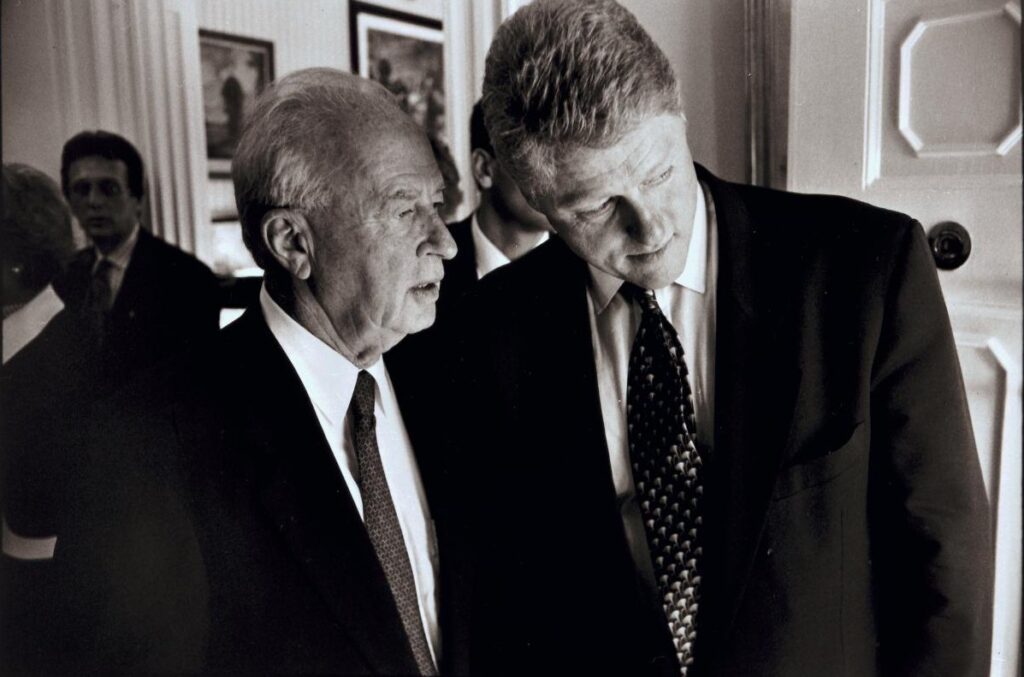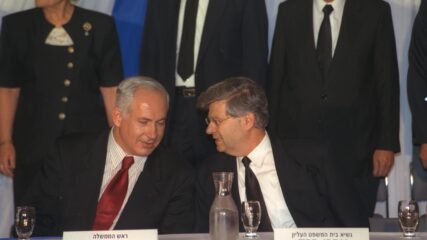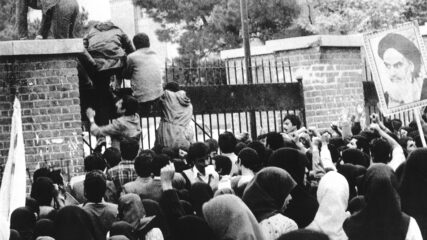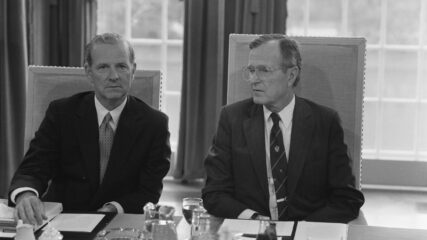July 1, 2025
Kenneth Stein, “US-Israel Relationship,” (Hazan, et al ed.) The Oxford Handbook of Israeli Politics and Society, Oxford University Press, 2018. http://www.oxfordhandbooks.com/view/10.1093/oxfordhb/9780190675585.001.0001/oxfordhb-9780190675585-e-29
* For citations and further readings, please see endnotes.
The U.S.-Israeli relationship is complicated, dynamic, multidimensional and enduring. It is, as Dennis Ross’ book title describes it, Doomed to Succeed (Ross, 2015). Former U.S. Ambassador to Israel Samuel W. Lewis said the “relationship exists like a marriage of old: You can love each other, yell at each other, disagree with each other, even leave each other for a period of time, but you do not get a divorce. It is deeper and wider than government-to-government. It is unique among all our relationships in the world” (Lewis, 2011). The relationship as defined by American policymakers has developed from open disdain for Jews, Zionism and a Jewish state in the 1940s to characterizing the U.S.-Israeli connection as a strategic asset in 2018 (Stein, 2018).
Ups and downs in the relationship have progressively evolved into a spider web of entrenched and mutually beneficial relations, connecting their respective bureaucracies, economies, militaries, educational institutions, scientific research and populations. There is no written treaty between the countries, but rather many understandings, letters of assurance, memorandums of agreement, congressional letters of support, weapons supply assurances, economic aid and technology agreements, intelligence-analyses-sharing agreements, and close partnerships in virtually all military and civilian fields. In the United Nations and in other international organizations where the world imbalance against Israel has been incessantly toxic, Israel has looked upon Washington to speak up on its behalf to oppose efforts aimed at harming and delegitimizing the state.
Entangling the state-to-state associations of the two countries are the rooted connections whereby the two largest Jewish communities in the world influence each other. Israel has had a profound impact on the definition and development of American Jewish identity. Likewise, American Jews have played supporting and at times intrusive roles in Israeli politics and policies.
For American Jews in particular, Israel is a lightning rod for political engagement in several spheres. Israel is the center where Jews interact with fellow Jews about self-definition and the care of Jews worldwide. Diaspora Jews, including those in North America, similarly identify with a resilient Jewish past and Israel’s story of perseverance and feel its pain at setbacks. Since the Six-Day War in June 1967, American Jews have increasingly articulated divergent views about policies Israel should adopt toward its Arab neighbors and particularly the Palestinians. For many American Jews, Israel is more than the re-establishment of an ancient homeland in the form of a modern nation-state. American Jews have made Israel a keen focus of their congregational and institutional activities, including it as a place to visit, learn, and take pride about a common Jewish past. Israel has evolved for many of them into an effective focal point for participation in the American political system — a process that has promoted strong support for the U.S.-Israeli relationship.
In the past four decades, with the advent of the 24-hour news cycle, there have evolved more frequent and unsparing rebukes of Israel’s political choices by Jewish scholars, clergy and organizations. And yet without much doubt, Jewish Americans feel a strong emotional connection with the Jewish state. A solid majority say they are either “very” or “somewhat” attached to Israel and that caring about Israel is either “essential” or “important” to what being Jewish means to them. The connection is felt both ways; most Israeli Jews say Jewish Americans have a good impact on the way things are going in Israel. In addition, most Israeli Jews say that a thriving Diaspora is vital to the long-term survival of the Jewish people and that Jews in the two countries share a “common destiny” (Pew Research Center, 2017; see the chapter by Sucharov in this volume).
The United States and the Middle East in Context
Washington’s relationship with Israel is only part of a much broader set of varied, competing, often well-defined but also frequently changing American interests in the Middle East. Understanding those interests allows for a firmer comprehension of the context within which the U.S.-Israeli relationship is situated. Among them are the following nine constants that make up American foreign policy objectives, some present since the end of World War II and others added more recently, all of which have had some direct or indirect influence on how the U.S.-Israeli relationship has unfolded. At one time or other, the United States has sought to:
- Preserve the stable existence of moderate Arab and Muslim states.
- Ensure the security of Israel.
- Safeguard access to Middle Eastern oil at reasonable prices.
- Protect and ensure physical access through Middle Eastern waterways (Suez Canal, Bab al-Mandab straits, Bosphorus-Dardanelles, and Strait of Hormuz).
- Deny infiltration to or reduce the strength of countries or ideologies that are hostile to Western values.
- Limit growth of views or insurgencies that are regional or transnational threats to the stability and preservation of moderate states and to the United States and its allies (Hamas, Hezbollah, ICIS, al-Qaeda, ISIS, Islamic radicalism).
- Curb the spread of regional terrorism and weapons of mass destruction.
- Promote religious freedom, human rights and self-determination.
- Engage in mediating Arab-Israeli negotiations.
American foreign policy concerns by necessity have remained more numerous than Israel’s unique and more narrow foreign policy priorities. In the second decade of the 21st century, with Middle Eastern countries tattered by civil wars, insurgencies, brutal autocracies, sectarian strife, transnational issues, burgeoning Iranian hegemony and massive refugee issues, there are more issues than Washington can hope to cope with in any effective manner. Even managing them, regardless of the administration in power, is a stifling undertaking. American interests in the Middle East in the 1950s in the midst of the Cold War were certainly less complex than those in 2018, although no less troubling.
American objectives in the Middle East since the end of World War II have tended to be status quo in orientation. Balancing interests while containing physical and ideological threats to the region has typified the definition and navigation of American foreign policy. Washington’s policy shifts to the Middle East and toward individual countries have occurred most often in responses to regional leadership changes and sudden unfolding events, with persistent fears that Middle Eastern conflicts would spill over into larger regional conflicts that would adversely affect the security of the United States.
Egyptian President Gamal Abdel Nassar’s rejection of American overtures in the 1950s helped push Washington closer to Israel; President Anwar Sadat’s voluntary engagement with the United States in the 1970s pushed Washington closer to an Arab leader, adding tolerable friction to the U.S.-Israeli relationship. Saddam Hussein’s invasion of Iraq in 1990 pushed Arab Gulf states toward Washington in search of upholding their security and territorial integrity against a regional bully. Those states in turn responded to American overtures that unfolded Arab-Israeli negotiations from the Madrid 1991 Middle East peace conference through the signing of the 1993 Oslo Accords.
The Soviet invasion of Afghanistan and the subsequent flight of Shah Reza Pahlavi in 1979 propelled America away from the almost exclusive geographic concentration (Arab-Israeli and Cold War issues) in the eastern Mediterranean to include the Gulf region. The September 2001 attacks on the United States, followed by American engagement in Afghanistan and Iraq, expanded America’s foreign policy priorities to focus on how to prevent the implosion of Arab state systems and extricate American military presence. The “Arab Spring” of 2011-2012 seriously undermined the fabric of half a dozen Middle Eastern states, emphasizing once again that in contrast, Israel was a reliable and supportive ally.
Well into the 1980s, Washington viewed its steps in the Middle East through the prism of Moscow. Detente became a vehicle for containment. Would any policy choice incur a slide toward a U.S.-U.S.S.R. face-to-face confrontation in the region? Fear of a superpower war in the Middle East repeated itself respectively during the 1956 Suez War, the Six-Day War in June 1967, at the end of the War of Attrition in August 1970 and again at the end of the Yom Kippur War in October 1973.
Could any action by Washington prevent a country like Lebanon or Jordan or any others from being taken over by leaders sympathetic to Moscow or communism? In the last 20 years, curbing the growth of al-Qaeda and the Taliban, containing Iranian nuclear adventurism, and figuring out how to respond to the Shia-Sunni chasm between Iran and most Sunni Arab Gulf states have absorbed America’s attention. Over this span, Washington’s foreign policy has sustained, broken and mended relationships with multiple countries and organizations. Since the June 1967 war, no country has been more of an advocate for Palestinian self-determination than the United States. Simultaneously, Washington has deepened its relationship with Israel to depths that could not have been remotely anticipated by anti-Zionist American State Department officials in the late 1940s. How has the U.S.-Israeli relationship changed, its complexities grown and its resilience been sustained?
The Relationship: Its Predicate and the Early Years
Steadfast political and religious precepts inextricably bind the two countries and their populations. Freedom, liberty, the rule of law, the struggle for self-determination, belief in God, capitalism, protection of individual rights, a free press, separation of powers, regular elections, and democratic forms of government unite the peoples in the two countries. Israel, with its absolute link to Jewish history, inherited a particular political culture unique to its size and its Jewish identity. As a minority wherever they lived, Jews were constantly insecure and living at the whim of others. That forced Jews to adapt and taught them to improvise and accommodate to both the more powerful and their surroundings. In forming a state, Zionists imbibed their sense of insecurity from centuries of precarious living, reworked with 19th- and 20th-century racial antisemitism, Hitler’s Germany, the Mufti’s actions and incantations, and later Arab leaders who bellowed to drive the Jews into the sea or at least expel them from their ancestral homeland.
Integral to Israeli foreign policy is the mantra “Never Again.” Jews should never be helpless or stateless again. To assure that objective is never compromised, Zionists and Israelis have remained in constant search for major powers, building relationships to ensure that tomorrow is reached. Israel’s small geographic footprint and population forced it to affirm a military doctrine to fight its wars and battles on the enemy’s territory. Israel’s civil religion is the devotion to its military readiness. As a state, its core strategic objectives include preserving the ability of a Jewish majority to make sovereign and independent decisions, protecting the physical security and economic well-being of its population, and keeping the state available as a key link to diaspora Jewry for purposes of identity and assistance to Jews in need or in crisis worldwide (see the chapter by Freilich in this volume).
Israel’s relationship with Washington has become Jerusalem’s most important state-to-state affiliation. Israel’s interest in an extraordinarily strong relationship with Washington enhances its national security. Washington’s relationship with Israel evolved slowly, grew marginally in the late 1950s, ripened to become more entwined after the June 1967 war, and thickened immensely from the 1980s forward. In the 1930s and 1940s, while the United States pulled through the Great Depression and fought wars in Europe and the Pacific, official U.S. State Department attitudes were blatantly antisemitic.
Indicating how expendable Jews were and that the United States was not going to provide them refuge, the U.S. State Department denied eligible Jewish refugees visas to enter the country. President Franklin D. Roosevelt’s secretary of state, Cordell Hull, and assistant secretary of state, Breckinridge Long, and those in the Western European division at the State Department, including Jay Pierrepont Moffat, William Carr and William Phillips, imposed immigration restrictions on Jews and suppressed information about Hitler’s extermination plans. This was all motivated by their personal dislike of Jews. The president himself refused to bomb Hitler’s Jewish extermination camps. In February 1945, two months before his death, FDR told Saudi Arabia’s King Saud at a meeting at the Suez Canal that he as the chief executive would “take no action … which might prove hostile to the Arab people” and “do nothing to assist the Jews against the Arabs,” and yet earlier the president had suggested to American Zionists that Palestine should be open to Jewish refugees (Stephens, 2006, p. 15; Radosh & Radosh, 2009, pp. 18-30). FDR’s attitudes and those of the Department of State reflected a decidedly pro-Arab stance and anti-Zionist mantra.
After World War II, Jerusalem connected initially with Washington while Israel was a state in the making. At that moment, its general populace had been seared by the brutal ravages of human loss in the Holocaust. It had a tiny population relative to its neighbors. Neighboring Arab leaders sought its destruction before its establishment. The head of the Arab League of States, Azzam Pasha, fervently declared in September 1947 to Jewish Agency representatives who offered a two-state solution, “You [Zionists] won’t get anything by peaceful means or compromise. … In all events, the [Zionist-Arab] problem now is only soluble by the force of arms. We were able to drive out the Crusaders, but on the other hand we lost Spain and Persia. It may be that we shall lose Palestine” (quoted in Horowitz, 1953, pp. 233-235).
After the British announced in 1947 their planned departure from Palestine, the British administration in Palestine and the Foreign Office in London vigorously, in word and deed, tilted toward Arab states and away from the Zionists, particularly after the United Nations voted for partition in November 1947. Britain’s objectives aimed at stifling the Jewish state’s emergence and seeking international approval to renew the British presence in Palestine, a two-pronged policy that was heavily endorsed by the U.S. State Department. Washington was the first country to recognize Israel after it issued its Declaration of Independence. A memo from Clark Clifford indicates that it was not so much the State Department that procrastinated in providing de jure recognition to Israel well into the middle of June 1948 as it was “Mr. Henderson’s own representations” to have Israel trade away some of its territorial gains because it is “necessary to conciliate the Arabs” (Clifford, 1948).
For the 1946-1948 period, memorandums written in the Department of State for Secretary of State George Marshall and President Harry Truman against a Jewish state, as evidenced in the Foreign Relations Documents of the United States, demonstrate virulent anti-Zionist outlooks. Loy Henderson, head of the Office of Near Eastern Affairs at the Department of State, admitted that while he served, he was “rabidly anti-Zionist” (Henderson, 1973). The largest array of any group of State Department officials ever who opposed Zionism and a Jewish state was present and virtually unanimous at the moment of Israel’s establishment.
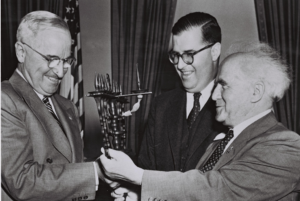
Henderson, formerly the U.S. minister in Iraq and later ambassador to Iran during the coup that restored the shah to power in 1953, was one of half a dozen key figures who all believed, in the strongest possible way, that a Jewish state was a grave political and strategic liability to the U.S. national interest. This was because support of Zionism meant aggravating America’s postwar fear about the aggressive nature of the Soviet Union and communism. The others included George Kennan, who was head of the policy planning staff at the Department of State; Under-Secretary of State Robert Lovett; his predecessor, Dean Acheson, who would become Truman’s secretary of state from 1949 to 1953; Charles Bohlen, the No. 3 person at the Department of State; Dean Rusk, then the director of United Nations affairs and later John Kennedy’s and Lyndon Johnson’s secretary of state (1961-1969); Secretary of State George Marshall (1947-1949); and Defense Secretary James Forrestal (1947-1949) (Clifford & Holbrooke, 2008).
Each of these officials inveighed publicly or privately against Zionism. Each proclaimed that the United Nations’ November 1947 General Assembly resolution to partition Palestine into Arab and Jewish states was contrary to American national interests and that Washington’s support of a Jewish state would ultimately lose Washington Arab allies and then put it on a military collision course with Stalin’s Soviet Union. The reasoning went that once the United States sided with Zionism and the establishment of a Jewish state, Arab states, which so feverishly opposed a Jewish presence in the eastern Mediterranean, would be driven into the unwanted embrace of the Soviet Union and communism. At that moment, the United States wanted to “contain” the Soviet Union’s expansionism in the eastern Mediterranean and not give Moscow easy access to new allies.
Moscow’s pragmatic U.N. support for a Jewish state had been clearly aimed at hastening the prospects for Moscow to fill any physical void left by a declining British influence in Palestine, perhaps ultimately hastening British departure from Transjordan and Egypt too. A third argument against a Jewish state was predicated on a real or imagined fear that Arab armies would crush the emerging Jewish paramilitary organizations. This in turn would force American military intervention to rescue Jews from another holocaust. In such an eventuality, it was reasoned that American troops would have to be stationed in the Jewish state to sustain its very existence.
If that occurred, the Soviet Union would find an excuse to confront the United States physically in the Middle East. Other articulated reasons to oppose partition, Zionism, and the establishment of a Jewish state included fear of jeopardizing US and its Western allies’ access to the Suez Canal and to Arab oil sources, as well as the belief that pro-Western Arab leaders would be tossed from office (Kennan, 1948).
The Relationship: Deepening and With Differences
Once the Cold War between the United States and Soviet Union emerged as the most dominant theme in international relations, it drove American presidents to view their relations with Middle Eastern states and with states elsewhere in the world through that prevailing prism. Proclaiming to contain Soviet aggression, prevent the spread and growth of communism, and thwart the evolution of Moscow-led alliances with client states, the United States for thirty years issued containment policies: in 1947 the Truman Doctrine, in 1957 the Eisenhower Doctrine, in 1980 the Carter Doctrine and in the 1980s the Reagan Doctrine.
In the Middle East, Washington supported states and alliance systems that would geographically curb Moscow’s penetration into the eastern Mediterranean. It cultivated warm relations with the southern tier of Muslim states that included Iran, Iraq, and Turkey. It supported Arab Gulf states as well as Israel. Gradually, however, Arab states went through a series of revolutions in which leaders from the earlier colonial period were cast from office or assassinated. When Egypt refused American financial support or an alliance with the United States in the early 1950s, then led by its charismatic president, Nasser, who advocated neutrality between the superpowers but actually aligned with Moscow, Israel became a beneficiary of Egypt’s tilt toward the USSR. Increasingly, Washington saw Israel as a stalwart against the spread of communism in the Middle East.
In 1958 fear of communist influences taking hold in Lebanon and Jordan caused the United States to send a small number of U.S. Marines to Beirut. Referring to the U.S. deploying Marines there, Secretary of State John Foster Dulles said, “If Israel [were the] victim of unprovoked aggression to destroy it, our response would be just as good as in [the] case of Lebanon” (Little, 1993, p. 566). In 1970, when it appeared that Moscow’s Syrian client would endanger the Jordanian regime, President Richard Nixon called upon Israel to make a public demonstration of military support for Jordan’s King Hussein ibn Talal. Arab leaders’ political decisions to assert control over their neighbors further alienated American friendships. In 1963 Nasser’s bold sorties into Yemen and efforts to unseat moderate Arab leaders in Jordan and Saudi Arabia tarnished America’s relationship with Cairo. The Kennedy administration clarified its moral and political commitment to the integrity and well-being of Israel and said it “would come to Israel’s assistance if Israel were the victim of aggression” (Little, 1993, p. 572).
The so-called southern-tier alliance of Middle Eastern states — Iran, Iraq, and Turkey — that were geographically appealing from Washington’s view to contain Moscow’s moves into the Middle East in the 1950s were no longer a valued system, with Tehran and Baghdad completely absent from any Western alliance system. By 2018, Ankara and Washington disagreed on an array of regional strategic issues. Israel and several Arab states were left willing to align with specific American interests such as curbing insurgencies, transnational terrorism, and containing Iran’s intention to acquire nuclear weapons capability. And virtually every Arab country ran from the Obama administration’s embrace of engaging Iran’s regime in a nuclear weapons deal, driving many into the quiet and deepening embrace of Israel.
Warming relations with Israel in the 1950s, while not forsaking Arab allies, were emblematic of what became Washington’s even-handed policy toward American friends in the Middle East. The 1967 June war did not change this “even-handedness.” Its results caused the United States to give the policy starker and more frequent definition (Stein, 2017; see also the chapter by Tal in this volume). Washington identified with Israel’s smashing success over Moscow’s Soviet clients. In solidifying Israel’s existence, the war gave Israel the option to trade the land it won in the war for peace or security. For the next half-century, the United States became the primary mediator seeking agreements between the Israeli and Arab sides. While the United States continued to increase American military and economic aid to Israel, it also leaned heavily on Israel to be more forthcoming in negotiations with the Arab side and especially the Palestinians.
In December 1967, Harold Saunders, the Middle East specialist at the U.S. National Security Council, remarked, “We’ll make sure Israel has our political support and equipment it needs to defend itself. But we can’t tie ourselves to ‘fortress’ Israel, especially if Israel decides to build nuclear weapons” (Saunders, 1967). Two years later, a longtime colleague of his in the Department of State, Undersecretary of State for Political Affairs Joseph Sisco, said, “Our interests in the Middle East do not center on Israel alone. Our moral and practical commitment to Israel is by no means toward everything Israel wants or does. Let me tell you frankly: If our friendship with Israel is the only thing the United States is left with in the Middle East, that will be a catastrophic setback for American policy [and national] … interests in the region” (Rabin, 1979, p. 149).
In December 1975, Henry Kissinger, in a private meeting with Saddun Hammadi, the Iraqi minister of foreign affairs, noted: “We don’t need Israel for influence in the Arab world. On the contrary, Israel does us more harm than good in the Arab world. We can’t negotiate about the existence of Israel, but we can reduce its size to historical proportions. … So I think in ten to fifteen years, Israel will be like Lebanon — struggling for existence, with no influence in the Arab world. … If the issue is the existence of Israel, we can’t cooperate. But if the issue is more normal borders, we can cooperate. … We want the survival of Israel but not dominating the area. What they want is what you predict — that they be the only friend. We want other friends, to reduce that argument” (Stein, 2006).
In the 1970-1981 period, Nixon, Gerald Ford, Kissinger and Jimmy Carter pushed Israel to make more and faster accommodations than it was prepared to undertake. Each embraced Sadat’s eagerness to entrust the keys to diplomatic progress to Washington. Sadat calculated that only the United States, with present and future security guarantees offered to Israel, could loosen Israel’s control over sovereign Egyptian Sinai. Capitalizing on Sadat’s willingness to move Egypt away from the Soviet Union was an American victory that could not be passed up. As Sadat told Kissinger in January 1974 at the signing of the first Egyptian-Israeli Disengagement Agreement, “We are making this agreement with the United States, not with Israel” (Stein, 1999. p. 51). In the negotiations that flowed from Cairo from 1973 to 1979, Sadat anointed Kissinger and then Carter as “his emissaries” to Israel.

A key sticking point in the U.S.-Israeli relationship since the June 1967 war has been the increase in frequency and in detail that American officials request of Israel to resolve regional conflict. Jerusalem and Washington possess vastly different views of what is in Israel’s national interests and how it should act in protecting itself, particularly in its relationship with Arab and Muslim neighbors (see the chapter by Rabinovich in this volume).
At almost every juncture when Washington has proposed what Israel should do, every Israeli prime minister, regardless of political leaning, has taken into account Washington’s positions and inevitably differed over what Israel sees as existential security threats, views that are not shared by Washington. Israeli prime ministers range from prickly to resentful when they view Washington as intruding into what Israel sees as its basic right and sole prerogative: to determine the last word on security matters. Israeli self-determination is the core of the Zionist enterprise that struggled to form a state. It is a non-negotiable essence of Israel’s statehood.
Israeli leaders have opposed, criticized, or had major reservations about unilateral statements, plans, and agreements made or supported by American officials or international organizations when those ideas have related to how Israel should dispose of the post–1967 war territories. Examples include the 1969 Rogers Plan; 1982 Reagan Plan; and U.S. abstention from five U.N. Security Council resolutions since the 1980s whose contents criticized Israel’s actions: annexation of land or building of settlements, including Jerusalem.
Added to this are the 2002 Arab Peace Initiative, the 2003 Quartet’s Roadmap, and the August 2015 Iran nuclear understanding. In one classic moment, Prime Minister Menachem Begin, incensed that Israel was being treated like a supplicant client state, reacted to a published report that the United States would be “punishing Israel” for applying Israeli law to the Golan Heights in December 1981. Upon hearing the remark, Begin summoned U.S. Ambassador Samuel W. Lewis and said, “What kind of expression is this — ‘punishing Israel’? Are we a vassal state of yours? Are we a banana republic? Are we youths of 14 who, if they don’t behave properly, are slapped across the fingers?” (Lewis, 2011).
The Relationship: Point, Counterpoint, Stronger Than Ever
Finally, two additional examples illuminate the intricacies of the U.S.-Israeli relationship. One pertains to the Ford administration and Prime Minister Yitzhak Rabin, the second to the Obama administration and Prime Minister Benjamin Netanyahu, 40 years apart. In 1975, when Secretary of State Kissinger wanted Israel to sign a second disengagement with Egypt, Israeli leaders had not yet come to trust Egyptian President Sadat. Kissinger did. In March 1975, Kissinger berated Rabin and Israel for not being forthcoming with Sadat. He said to Rabin, “The Arab leader who banked on the U.S. is discredited,” and then threatened Israel with “greater emphasis on the Palestinians.” He continued, “The Soviets will step into the area, we shall not oppose the resumption of a Geneva Conference … that is my nightmare marching to you” (Ford, 1975, p. 560).
Rabin characterized this talk with Kissinger as the “toughest, most emotional, and most painful conversation” the two of them ever had. Subsequently, President Ford announced a “reassessment” of U.S. relations with Israel. Rabin knew that Sadat and Kissinger wanted another agreement. Further, he knew the U.S.-Israeli relationship would not suffer in the short or long term, and particularly that the United States was not about to go to a Middle East conference at which the Soviet Union would be a co-convener with Washington, especially after Kissinger had diligently squired Sadat away from Moscow. Rabin was a pragmatist who could see beyond the immediate horizon.
Yet “reassessment” took several forms: restriction of arms supplies and suspension of economic assistance and a selective embargo were applied. Ford froze the Israeli request for F-15 fighter planes and delayed the delivery of a promised shipment of Lance surface-to-surface missiles. Kissinger recommended that “every department should put Israeli activities at the bottom of the list” (Kissinger to President Ford, 1975).
Undercutting the Ford-Kissinger tandem was Israel’s overwhelming support from Congress in a letter signed by 76 senators calling for undiminished military and economic aid to Israel. The senators wrote, “We trust that your recommendations will be responsive to Israel’s urgent military and economic needs … the US acting it is own national interests, stands firmly with Israel in the search for peace” (Spiegel, 1985, p. 296). Bipartisan support for Israel was strongly expressed, and it greatly angered the administration because congressional and lobbying interests shackled executive branch decision-making.
When Rabin next met with Ford at the White House in June 1975, he told the president that Israel would not return to the pre-1967 borders. Finally, Israel agreed to withdraw from the strategic Sinai passes if the United States agreed to station Americans as civilian observers in Sinai and made other promises to Israel not to negotiate with the Palestine Liberation Organization unless it renounced terrorism and accepted Israel.
In early September 1975 the second Egyptian-Israeli disengagement agreement was signed. In addition, completely disconnected from the Egyptian-Israeli focus, the United States promised in a secret Ford-Rabin agreement that the “U.S. would give great weight to Israel’s position that any peace agreement with Syria must be predicated on Israel remaining on the Golan Heights” (Stein, 1999, p. 51). In negotiations with Washington, Israel achieved its immediate negotiating objectives, retained its military arms delivery, and obtained something more in the Ford promise to Rabin about the Golan Heights.
The heated U.S.-Israeli controversy over the 2015 Iran deal is a second example of both countries pushing their views on the other, of the relationship being full of anger, and of it remaining robust years after what was an extraordinarily harsh encounter. The prelude to the controversy occurred with the change in the Obama administration’s outlook toward Iran. That outlook began as quite harsh, then mellowed, compromising with Tehran to the point that the Israeli prime minister reacted with unrestrained anger. Speaking at the Rabbinical Assembly in Atlanta in May 2012 and in Jerusalem in March 2013, Vice President Joseph Biden and President Barack Obama respectively had noted that Washington’s policy regarding Iran was not “containment.” That is, Iran would not be allowed to retain a nuclear weapon.
In September 2013 the administration softened its view toward Iran when President Obama merely said, “We are determined to prevent Iran from developing a nuclear weapon; we are not seeking regime change and we respect the right of the Iranian people to access peaceful nuclear energy” (Obama, 2013). A heavy sigh of relief from the Iranian regime about such a promise after years of Israel debating over whether to attack Iran and stop its nuclear quest was palpable. Israel’s and Iran’s Arab opponents were greatly troubled by Obama’s promise.
Over the next 18 months the United States and the major powers hammered out an agreement with Tehran wherein the financially burdensome U.N. and U.S. sanctions on Iran would be removed in exchange for severe limitations on Iran’s access to nuclear weapons production. While the agreement was negotiated, optics in the bilateral public relationship soured as much as they had anytime previously between the United States and Israel, including during the waning days of the Carter administration, when Prime Minister Begin had made it clear to anyone who wanted to listen that Jimmy Carter should not be re-elected for a second term as president. And through it all, the Obama administration continued to provide Israel with arms supplies for its national defense needs.
Relations between Obama and Netanyahu became outright surly during the last 18 months of the Obama administration. At the end of February 2015, over the matter of the Obama administration designing an agreement with Iran, the country most able and willing to pose an existential threat to Israel, Israeli Prime Minister Netanyahu accused the United States of “giving up” on stopping Iran from developing a nuclear weapon.
National Security Adviser Susan Rice responded by proclaiming that Netanyahu’s visit to the United States at the invitation of the Republican speaker of the House of Representatives, which included an address to a joint session of Congress, was “destructive of the [bipartisan] fabric of the [U.S.-Israel] relationship” (Rice, 2015). Netanyahu’s 40-minute speech against the deal being negotiated was as intrusive an act into American politics as any undertaken previously by a prime minister of Israel on behalf of the defense of Israel’s national interests. For its part, the Obama administration worked to have Netanyahu’s March 2015 re-election fail. Friendly analysts of the relationship on all sides estimated that the president and prime minister’s sullen unfriendliness had reached a historic low point that threatened to put the Washington-Israeli relationship into an irretrievable deep freeze, similar to but expected to be much longer than the Ford “reassessment” in 1975.
Many pro-Israel American Jewish leaders, Democrats and Republicans among them, expressed deep anger at the Israeli prime minister for coming to Congress and opposing a sitting U.S. president. (This was the fifth time an Israeli prime minister had addressed a joint session of Congress, a record for prime ministers or heads of state addressing joint sessions since World War II.) In July 2015 the Joint Comprehensive Plan of Action (JCPOA) was signed between Iran on the one hand and China, France, Germany, Russia, the United States, the United Kingdom and the EU on the other. It was reinforced by a U.N. Security Council resolution. In September 2016 the United States finalized a $38 billion package of military aid for Israel, to last into 2028.
In the last 10 days of December 2016, the Obama administration pummeled Israel at the United Nations. U.N. Security Council Resolution 2334 was passed December 23. It labeled Jerusalem as occupied territory. The American ambassador to the U.N. abstained, allowing it to pass. Five days later, showing his anger toward Netanyahu, Secretary of State John Kerry delivered a blistering attack on Israeli policies (U.N., 2016a, 2016b). It was as detailed a criticism of Israel as perhaps has ever been made by a U.S. secretary of state. The prolonged and extraordinarily angry tiff between Netanyahu and Obama abruptly ended when the latter left office. And when Obama left office, two highly respected analysts, Amos Harel and Shai Feldman, praised his administration for bringing the two countries’ defense relations to a level of cooperation and intimacy not previously seen (Feldman & Harel, 2017).
Years after the signing of the JCPOA, the controversial differences between Israel and the United States over the Iranian nuclear threat or management of the negotiating process remain. In context, the U.S.-Israeli relationship is remarkably healthy, although not without pockmarks. One example was President Donald Trump’s December 2017 announcement of U.S. preparedness to move the U.S. Embassy to Israel’s capital, Jerusalem. Vice President Mike Pence reaffirmed that decision with his entwined embrace of Israel, its people and its history in his January 2018 speech to the Knesset. The United States moved the embassy that May.
From 2018 forward, six major issues shaped and deepened the U.S.-Israeli relationship:
- Sustaining U.S. support for Israel’s qualitative military edge over its adversaries through military and economic assistance.
- Debates on when and how some arrangement might evolve into implementable Palestinian self-rule, sometimes defined as the pace toward and away from a two-state solution.
- Stewardship by the Trump administration to recognition agreements between Israel and four Arab states, the UAE, Bahrain, Morocco and the Sudan, in 2020.
- Matters pertaining to Iran, including the Trump administration’s 2018 withdrawal from the JCPOA and Israel’s persistent fear of Iran achieving nuclear weapon capacity and the ability to deliver such a weapon.
- The buildup in tensions and violence between Israel and Hamas that exploded with Hamas’ October 7, 2023, attack, which killed 1,200 and wounded several thousand Israelis and others and took 251 hostages, and produced an Israeli military response that lasted 600-plus days. Israel with American urging degraded and decimated Iranian proxies in Lebanon (Hezbollah) and Syria and among Hamas’ leadership cadre.
- Bipartisan American diplomatic and military support for Israel’s military responses, including Washington’s dispatch of massive numbers of equipment and primarily air support. The U.S. assistance included the U.S. Air Force’s bombing of Iranian nuclear facilities June 21, 2025.
By July 2025, the Hamas-Israel war in Gaza had not ended, all hostages and bodies of dead hostages had not been returned, and the possibility of tying together more Arab Gulf states to an informal alliance with Israel through the U.S. was still in process.
What was clear from the events from 2018 forward was that the U.S.-Israel strategic relationship, which harkened back to the 1960s, was still strong and perhaps more collaborative than ever. June 2025 was the first time that the U.S. militarily joined in a war with Israel against a common adversary.
References
Clifford, C. (1948, June 17). Foreign relations of the United States: The Near East, South Asia and Africa (1948). Memorandum to the President, 5(Pt. 2), 1117–1118.
Clifford, C., & Holbrooke, R. (2008, May 1). President Truman’s decision to recognize Israel. Jerusalem Viewpoints. Retrieved from http://jcpa.org/article/president-truman%E2%80%99s-decision-to-recognize-israel/
Ford, G. 1975. Remarks to Israeli Prime Minister Rabin, March 21, 1975, Foreign Relations of the United States FRUS 1969-1976, Vol XXV, Document 156, p. 560.
Feldman, S., & Harel, A. (2017, January 17). Obama and Israel: Farewell to a true friend. The National Interest. Retrieved from http://nationalinterest.org/feature/goodbye-barack-obama-hello-israel-19087
Henderson, L. (1973). Oral history interview, paragraph 100. Harry S. Truman Library, Independence, MO.
Horowitz, D. (1953). State in the Making. New York: Knopf.
Kennan, G. (1948, February 24). US government’s future position on Palestine. Center for Israel Education. Retrieved from https://israeled.org/resources/documents/us-governments-future-position-palestine/
Kissinger, H. (1975). Memorandum of a conversation with Saddun Hammadi. National Security Archive Electronic Briefing, Book No. 192. Washington DC: George Washington University. https://www.meforum.org/articles/2006/henry-kissinger-to-iraq-in-1975-we-can-reduce-is
Kissinger to President Ford (1975). Memorandum of Conversation, March 24, 1975, Document 159, Foreign Relations of the United States 1969–1976, Vol XXV, p. 563.
Lewis, S. W. (2011). Conference on the US-Israeli relationship. Miami, FL: Scholars for Peace in the Middle East.
Little, D. (1993). The making of a special relationship: The United States and Israel, 1957–1968. International Journal of Middle East Studies, 25(4), 564.
Obama, Barak. (2013). Speech at the United Nations General Assembly, September 24, 2013. https://obamawhitehouse.archives.gov/the-press-office/2013/09/24/remarks-president-obama-address-united-nations-general-assembly
Pew Research Center. (2017, January 24). American and Israeli Jews: Twin portraits from Pew Research Center surveys. Retrieved from http://www.pewforum.org/essay/american-and-israeli-jews-twin-portraits-from-pew-research-center-surveys/
Rabin, Y. (1979). Remarks by Joseph Sisco. In Yitzhak Rabin (Ed.), The Rabin Memoirs (p. 149). Boston: Little Brown.
Radosh, A., & Radosh, R. (2009). A safe haven: Harry S. Truman and the founding of Israel. New York: HarperCollins.
Rice, Susan. (2015). Remarks by Susan Rice, US National Security Adviser, NYT, February 25, 2015.
Ross, D. (2015). Doomed to succeed: The U.S.-Israel relationship from Truman to Obama. New York: Farrar, Straus and Giroux.
Saunders, H. (1967). Rough sketch of package for Eshkol. Countries: Israel. Box 144, National Security Files, LBJ Library.
Spiegel, S. L. (1985). The other Arab-Israeli conflict: Making America’s Middle East policy. Chicago: University of Chicago Press.
Stein, K. W. (1999). Heroic diplomacy: Sadat, Kissinger, Carter, Begin, and the Quest for Arab-Israeli Peace (). New York: Routledge.
Stein, K. W. (2006). “Henry Kissinger to Iraq in 1975: ‘We Can Reduce Israel’s Size’” Middle East Quarterly, 13(1), 214–223.
Stein, K.W. (2017). The June 1967 War: How it changed Jewish, Israeli, and Middle Eastern history. Center for Israel Education. Retrieved from https://israeled.org/product/june1967/
Stein, K. W. (2018). American officials on Zionism, Israel, and the US-Israeli relationship, selected remarks, 1947–2016. Center for Israel Education. Retrieved from https://israeled.org/wp-content/uploads/2012/02/US-diplomats-on-Israel-and-ME-QQ.pdf
Stephens, E. (2006). US policy towards Israel: The role of political culture in defining the “special relationship”. Brighton, UK: Sussex Academic Press.
United Nations. (2016a, December 23). UN Security Council resolution 2334 on Israeli settlements and East Jerusalem. Retrieved from https://israeled.org/resources/documents/text-egyptian-drafted-unsc-resolution-2334-israeli-settlements/
United Nations. (2016b, December 28). Secretary of State John Kerry’s remarks about the Middle East and Arab-Israeli negotiations. Retrieved from https://israeled.org/resources/documents/secretary-state-john-kerrys-remarks-middle-east-arab-israeli-negotiations/
Further Reading:
Cohen, R. (1994). Israel’s starry-eyed foreign policy. Middle East Quarterly, 1(2). Retrieved from http://www.meforum.org/221/israels-starry-eyed-foreign-policy
Eisenstat, M., & Pollock, D. (2012). Asset test: How the United States benefits from its alliance with Israel. Strategic Reports 7. Washington Institute for Near East Policy. Retrieved from http://www.washingtoninstitute.org/policy-analysis/view/asset-test-how-the-united-states-benefits-from-its-alliance-with-israel
Lewis, S. W. (1999). The United States and Israel: Evolution of an unwritten alliance. Middle East Journal, 53(3), 364–378.
Lewis, S. W., & Stein, K. (1991). Making peace among Arabs and Israelis: Fifty years of negotiating experience. Washington, DC: United States Institute for Peace. Retrieved from http://www.usip.org/sites/default/files/file/lewis_stein_monograph.pdf
Mead, W. R. (2008). The new Israel and the old: Why Gentile Americans back the Jewish state. Foreign Affairs, 87(4), 28–46.
Safran, N. (1981). Israel—The embattled ally. Cambridge, MA: Harvard University Press.
Saunders, H Middel East NSC adviser to Walt Rostow “Rough Sketch of Package for Eshkol,” 29 December 1967; Countries: Israel, Box 144, National Security Files, LBJ Library.
Spiegel, S. (2008). The American-Israeli relationship: Past and future. Israeli Journal of Foreign Affairs, 2(3), 15–28.
Zanotti, J. (2017). Israel: Background and U.S. relations in brief. Washington, DC: Congressional Research Service. Retrieved from https://fas.org/sgp/crs/mideast/R44245.pdf

